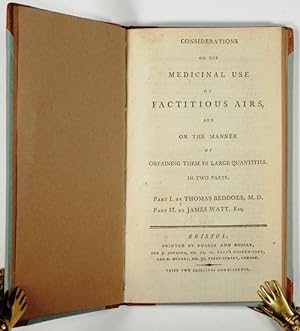WATT, JAMES; BEDDOES, THOMAS (2 Ergebnisse)
Produktart
- Alle Produktarten
- Bücher (2)
- Magazine & Zeitschriften
- Comics
- Noten
- Kunst, Grafik & Poster
- Fotografien
- Karten
-
Manuskripte &
Papierantiquitäten
Zustand
- Alle
- Neu
- Antiquarisch/Gebraucht
Einband
- alle Einbände
- Hardcover (1)
- Softcover
Weitere Eigenschaften
- Erstausgabe
- Signiert
- Schutzumschlag
- Angebotsfoto (1)
- Kein Print-on-Demand
Land des Verkäufers
Verkäuferbewertung
-
MEDICAL CASES AND SPECULATIONS; INCLUDING PARTS IV. AND V. OF CONSIDERATIONS ON THE MEDICINAL POWERS, AND THE PRODUCTION OF FACTITIOUS AIRS
Verlag: J. Johnson, Bristol, 1796
Anbieter: Second Story Books, ABAA, Rockville, MD, USA
Erstausgabe
Hardcover. First Thus. Octavo, [2], ix-xv (missing earlier pages), [1], 2**-2*****, [1], 4-168, 23, [1], *26-*41, [1], [3], 28-86, **86-***********86, 87-96, with plates. Fair; rebound in modern blue cloth boards with black cloth spine and corners, very little wear to edges or corners; binding tight; text block rough, uneven and age-toned; age-toning to pages, and deep foxing to middle signature pp 4-23; 2 plates present and intact labeled Pl. 4 and Pl. 5 with some offsetting; MF consignment. 1358322. Special Collections.
-
Considerations on the Factitious Airs, and on the Manner of obtaining them in large Quantities, in two Parts. Part I. By Thomas Beddoesd, M.D. Part II. By James Watt, Esq.
Erscheinungsdatum: 1794
Anbieter: Antiq. F.-D. Söhn - Medicusbooks.Com, Marburg, Deutschland
Buch Erstausgabe
Bristol : Printed By Bugin and Rosser, (1794), 8°, 48; 32 pp., 3 z.T. gefalt. Kupferstichtafeln, feiner Halbledereinband mit Rvg. und Rückenschild; feines Exemplar. Very Rare First Edition! Part I. A Familiar Explanation of the Principles on which Benefit may be expected from Factitious Airs in Various Diseases. Part II. Description of an Air Apparatus; with Hints respecting the Use and Properties of Different Elastic Fluids. By James Watt. Illustrations: The three plates show Watt's pneumatic apparatus for administering the gas. "This is the rare first edition of the Beddoes-Watt tract. In the second edition which was much expanded (1795: 168, 40 pp.) Beddoes states: "The former edition of this pamphlet, consisting of between 500 and 600 copies, appeared in the middle of October, 1794. The booksellers had disposed of most of the copies in a few weeks; and in less than four months a new impression became necessary." Of Watt's contribution the D.N.B. states: "Watt had his interest in chemical science still further stimulated by the hope of benefiting the health of his invalid son, Gregory, by the inhaling of gases, called in those days 'factitious airs.' This mode of cure was advocated by the celebrated Dr. Thomas Beddoes, and Watt devised an apparatus to be used in hospitals, and of a smaller size in private houses, for the generation of the 'airs,' and in 1795 published a pamphlet [the second edition], with illustrations, prices, and directions for use. Two principal 'airs' were to be produced, the one oxygen and the other hydro-carbonate; this appears to have been a mixture of hydrogen, carbonic acid, and some carbonic oxide. This horrible compound was not supposed to be of the best kind, nor to do its work properly, unless it had the effect of producing in the unhappy inhaler an attack of vertigo." Fulton & Stanton I,8 Nitrous Oxide : "The use of volatile agents to abrogate sensation had its primary origin in the work of three men: Joseph Priestley, Thomas Beddoes, and Humphry Davy. In 1772 Priestley discovered nitrous oxide, and he was also largely responsible for introducing the modem chemical study of the gases. He had not observed the exhilarating effects of nitrous oxide inhalation, but after discovering oxygen in 1774 he cautiously suggested that inhalation of certain gases might be of therapeutic benefit, particularly for diseases involving the lungs. His suggestion was taken up both in England and on the Continent, and Thomas Beddoes of Bristol was so impressed by Priestley's studies that in 1794 he and James Watt, the inventor of the steam-engine, published a book on the medical uses of die so-called "factitious airs," which enjoyed great popularity." Fulton & Stanton, p.8 The first part by Beddoes covers experiments that he conducted on humans and animals subjected to inhaling various gases. "The most important contribution to the study of therapeutic inhalation in general was made by Thomas Beddoes." Duncum, The Development of Inhalation Anaesthesia, pp. 64-70. "Perhaps the first modern gas inhaler was the one that James Watts, an engineer, constructed for Thomas Beddoes." Thomas, E. Keys, The History of Surgical Anesthesia, p.83 John F. Fulton & Madeline E. Stanton, The Centennial of Surgical Anesthesia (1946), I, 8.



